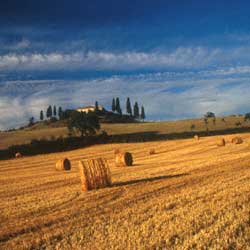|
 The
Val d'orcia stretches from the hills south of Siena to Monte
Amiata, and is made up by gentle, carefully-cultivated hills occasionally
broken by gullies or patches of erosion. The
Val d'orcia stretches from the hills south of Siena to Monte
Amiata, and is made up by gentle, carefully-cultivated hills occasionally
broken by gullies or patches of erosion.
Towns and fortified villages have been built on the higher hills. San
Quirico d'Orcia, for example. The splendid Horti Leonini gardens
are well worth a visit; Duke Diomede Leoni, who ruled San Quirico from
about 1570 onwards, had them built inside the fortified walls of
the town. Access is through a door on top of which are two lion's heads
with a Latin epigraph, a reference to the owner's name. The economy
of the town is based on tourism, the quarrying of travertine,
and agricultural trade.
The fortified town of Montalcino, settled first by the Etruscans
and then by the Romans, is situated on the summit of a hill that has a
commanding view of the surrounding valleys. It once flew the flag of the
Sienese Republic, but despite the important historical and artistic attractions
of the town, Montalcino is known throughout the world as the home
of Brunello, an exceptional wine that first saw the light
of day in the middle of the 19th century when Ferruccio Biondi Santi decided
to use only Sangiovese grapes.
Near Montalcino, and set amidst vineyards and olive groves, lies the Abbazia
di Sant'Antimo. The only certain date is that in the year 814 it had
jurisdiction over the territory of Montalcino. The complex is one of the
most attractive examples of 12th century monastic architecture. The magnificence
of the abbey, built from a particular kind of veined travertine
that makes it luminous, is enhanced by the beauty of the surrounding countryside.
Pienza is not a particularly ancient city. It was constructed
over the older settlement of Corsignano on the orders of Pope Pio II (Enea
Silvio Piccolomini). Not only was it one of his possessions, it was also
his birthplace and he wanted to create something to demonstrate his magnificence.
In 1459 he awarded the commission for the work to a pupil of Leon Battista
Alberti named Rossellino, who employed the best artists of the period
on this massive project. The result was a small gem of Renaissance
architecture.
Bagno Vignoni has been known for its thermal springs since ancient
times and this village has a truly unique atmosphere. The main piazza
is basically an enormous bath filled with steaming water (though
unfortunately it is not at present possible to bathe in it). This was
the original thermal bath, and visitors included Pope Piccolimini, Lorenzo
il Magnifico, and Santa Caterina da Siena, to whom the gallery
and chapel flanking part of the piazza are dedicated. She was apparently
in the habit of bathing close to the point where the 52-degrees-centigrade
water emerged, not as a health cure but to mortify her flesh with
the penitence of pain. Modern-day Bagno Vignoni has baths equipped
for thermal cures.
The town of Castiglione d'Orcia is situated on a spur that dominates
the valley, and developed beneath the imposing bulk of the ancient Rocca
degli Aldobrandeschi, from which there are wonderful views of the
valley and of Monte Amiata.
Picture by Sandro Santioli
|